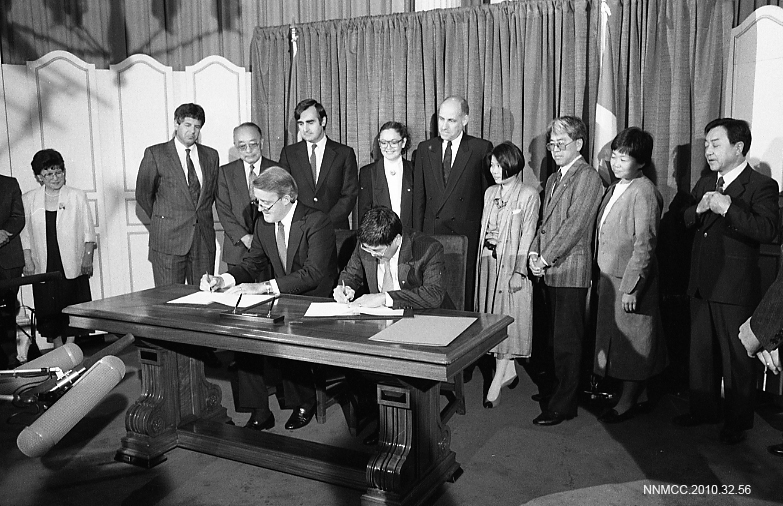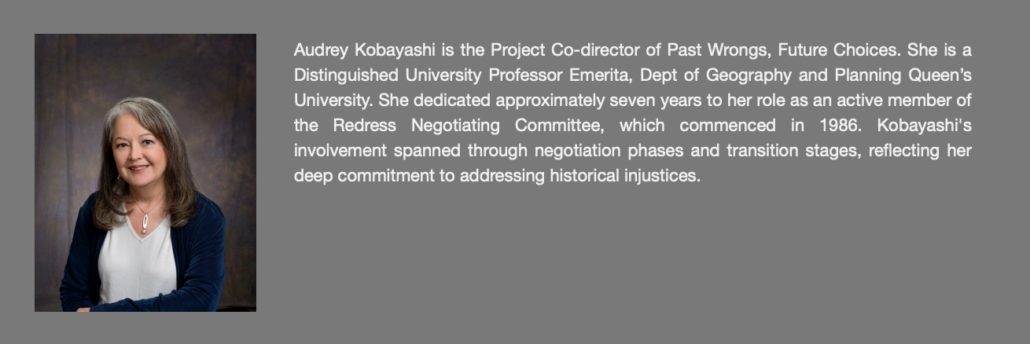March 2024 Project Director’s Message from Audrey Kobayashi

Audrey Kobayashi, fifth from the left, witnesses Brian Mulroney and Art Miki sign the redress.
With the news last week of Brian Mulroney’s passing, the papers have been full of stories about his time as Prime Minister. Although I had no time for his economic policies, Mulroney was above all a “Red Tory,” whose sense of justice and commitment to human rights was unequalled. And, of course, it was he who presided over the September 1988 Redress Settlement with Japanese Canadians.
I shall never forget the day that Art Miki called me to say that I and other members of the Negotiating Committee should meet at a downtown Montreal hotel for what turned out to be a momentous week in August 1988. In secret, we were led through the kitchens and up a back staircase to a room containing Lucien Bouchard, at that time Mulroney’s right-hand person, Gerry Weiner, Minister of Multiculturalism, and various governmental officials. For several years we had been sparring, to various degrees, with representatives of the three previous Prime Ministers. Now, at last, we seemed on the verge of a breakthrough.
Next morning we convened at another Montreal hotel and, for the next several days, we hammered out what came to be known as the Japanese Canadian Redress Agreement, finally announced in the House of Commons on September 22nd. The Order-in-Council was read to resounding applause, cheering, and an all-party standing ovation. As the now famous photograph shows, the Agreement was signed by Brian Mulroney and Art Miki. Across Canada, Japanese Canadians celebrated. Mr Mulroney was gracious and totally committed. I had never felt so Canadian.
So what did the agreement mean for Past Wrongs and Future Choices? For those Issei and Nisei who received a cash settlement, it lifted a burden of shame and meant far more than the money itself. It set communities across the country on a course of rebuilding community infrastructure. It established the Canadian Race Relations Foundation, which has sadly not lived up to our optimistic hopes. Several legal steps assured that full citizenship was guaranteed for everyone who had been affected by the 1940s invocation of the infamous War Measures Act.
But there was more than the official provisions. In the lead up to the Agreement, Japanese Canadians had come together as never before in their commitment to justice, and we nowlive in a community infused with a sense of justice. The facts of the uprooting and dispossession were brought into the open, as people realized that the government had actually acknowledged injustice in a meaningful and sincere way. In the course of staging the redress campaign our community had forged alliances with others: Indigenous, ethnocultural, religious groups, unions and activists. Since 1988, scholarship and the arts have flourished. Both our projects, Landscapes of Injustice, and Past Wrongs, Future Choices, have benefited immensely from that development. I believe we have become a catalyst for new directions that are leading to more public awareness, recognition, and commitment to the hope that what happened to Japanese Canadians can never happen again, to any group.
When I look around at the world today, that last hope looks unfounded. But I still believe that the Redress Settlement did its part, and I credit Brian Mulroney for his foresight and commitment.


 Instagram
Instagram